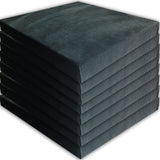SHORT ANSWER:
Rule of thumb usually calls for 15-30% of total area coverage
LONG ANSWER:

Hi and thanks for stopping by!
As the director of customer service for Acoustic Sound Panels, I try to keep a tally of the most commonly asked questions to help guests like you fill in the gaps among the sea of information that is out there on the web. What we found is most people looking for acoustic sound panels and room treatment to quiet unwanted noise suffer from information overload.
It seems that internet trolls and other evil doers, in attempts to exercise their mean little fingers, try to use big words and long winded confusing concepts when explaining room treatment for "proper" sound absorption. I say if you can't explain it to people in simple terms, you really don't understand it!
By this point, I'm sure you agree and want to know "How Much Acoustic Sound Treatment Do I Need?" Here it is, plain and simple.... it depends. Stay with me now. There are a few basic questions to ask and we can figure out what is right for your exact situation.
First, what is the nature of the noise issue that you are trying to address? Do you want to make a room sound better acoustically or do you want to sound proof your space so that no one can hear the sound coming from your room? Let's start with covering "Sound Treatment."
Second, what size acoustic panel do I need? That will depend what types of sound are we treating. Bass Guitar / Drums and other lower frequencies would best suited with acoustic bass traps at least 4" thick or acoustic corner traps which are 13" at the deepest point. However, if you are treating a call center with loud voices or a space with other mid to high frequencies then 2" acoustic panels will do the job properly.
Now for the most important question of all... "How many sound panels do I need?" In most cases, acoustic treatment is unfortunately an after thought that rears it's ugly head after construction is complete or the budget is otherwise depleted. Let me be clear that no two rooms are ever the same and the exact numbers can fluctuate. But don't get paralysis by analysis, you have to start somewhere. Here is a rule of thumb that works for the majority of our customers. Multiply the Height (H) x Length (L) for all 4 walls in the room. Then add the Height (H) x Length (L) from each wall. That will leave you with the total square footage of your wall space.
EXAMPLE:
Let's say your room has 4 walls that are 10' tall and 10' long.
Wall 1 10' (H) x 10' (L) = 100
Wall 2 10' (H) x 10' (L) = 100
Wall 3 10' (H) x 10' (L) = 100
Wall 4 10' (H) x 10' (L) = 100
This leaves you with a total area of 400'
In most cases you will be happy with 15 - 30% coverage. For a home theater or very noisy room (think concrete walls or a gymnasium) up to 50% will be necessary. You will at that point even consider treating the ceiling as well. If our example room requires 25% coverage, we multiply our total area of 400' by .25 and determine that we need 100 SQ feet of coverage or about (12) 2' x 4' acoustic sound panels Prefer a different size? Don't worry, you aren't limited to 2' x 4' panels. We have many different standard sizes to pick from, but you may need a specific size built. That is not a problem, we build 1000's of custom sound panels each year we and are happy to build the exact panels that suits your needs.
Lastly, after you receive your custom acoustic treatments you will want to know where to place the acoustic sound panels. Great news... we cover that in another blog article titled "Where Should I Place My Sound Panels"
I hope this helps shed some light on the decision process. If not, no worries, we help people like you make the right decision on how to resolve noise problems on a daily basis and are happy to help you.
Each room is different and we understand this can be confusing so feel free to call CUSTOMER SERVICE 1-800-649-6278 and we can help you make sure that you only get what you NEED.
We're looking forward to hearing from you.


